Quantitative analysis of the effect of synchronous online discussions on oral and written language development for efl university students in Vietnam
The study investigates the effects of synchronous online discussions on oral and written skills development for EFL university students in Vietnam after one semester of instruction, using a pretestposttest quasi-Experimental approach. One 15-student class of B1-level English participated in oral role plays, whereas another 15-student class engaged in synchronous online discussions after comparable preparation. The results show no statistically significant differences in oral and written proficiency between the two treatment groups at the end of the semester. However, students in both groups achieved great progress in speaking and writing skills, especially speaking skill after one semester. The fact that the group which used written chat during the treatment had better scores in the oral test at the end of the semester strengthens the belief that online discussions support the development of the same processes that underlie oral speech. Synchronous online discussions are thus shown to be a valuable addition to the foreign language classroom in terms of second language acquisition and learners’ language development
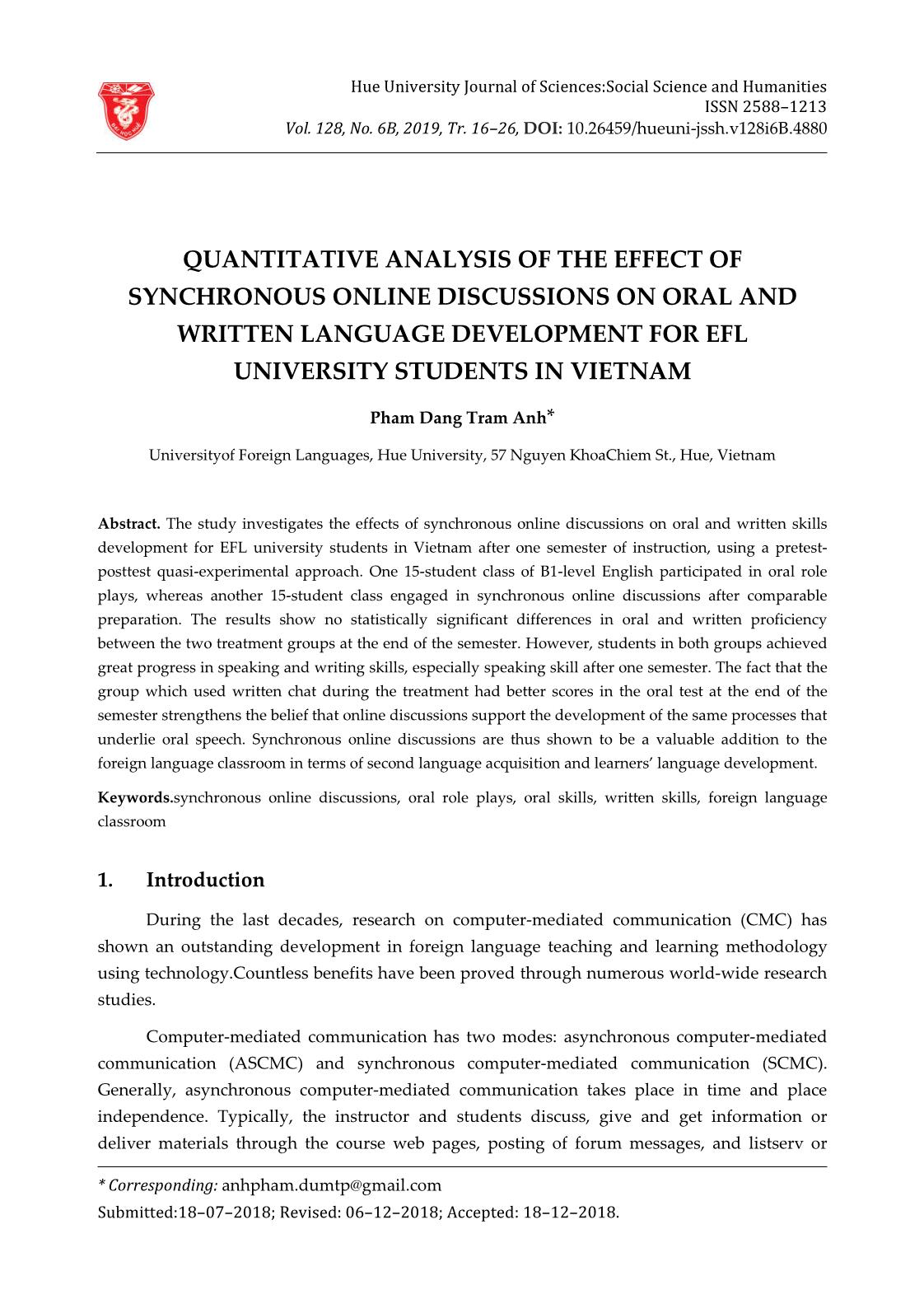
Trang 1
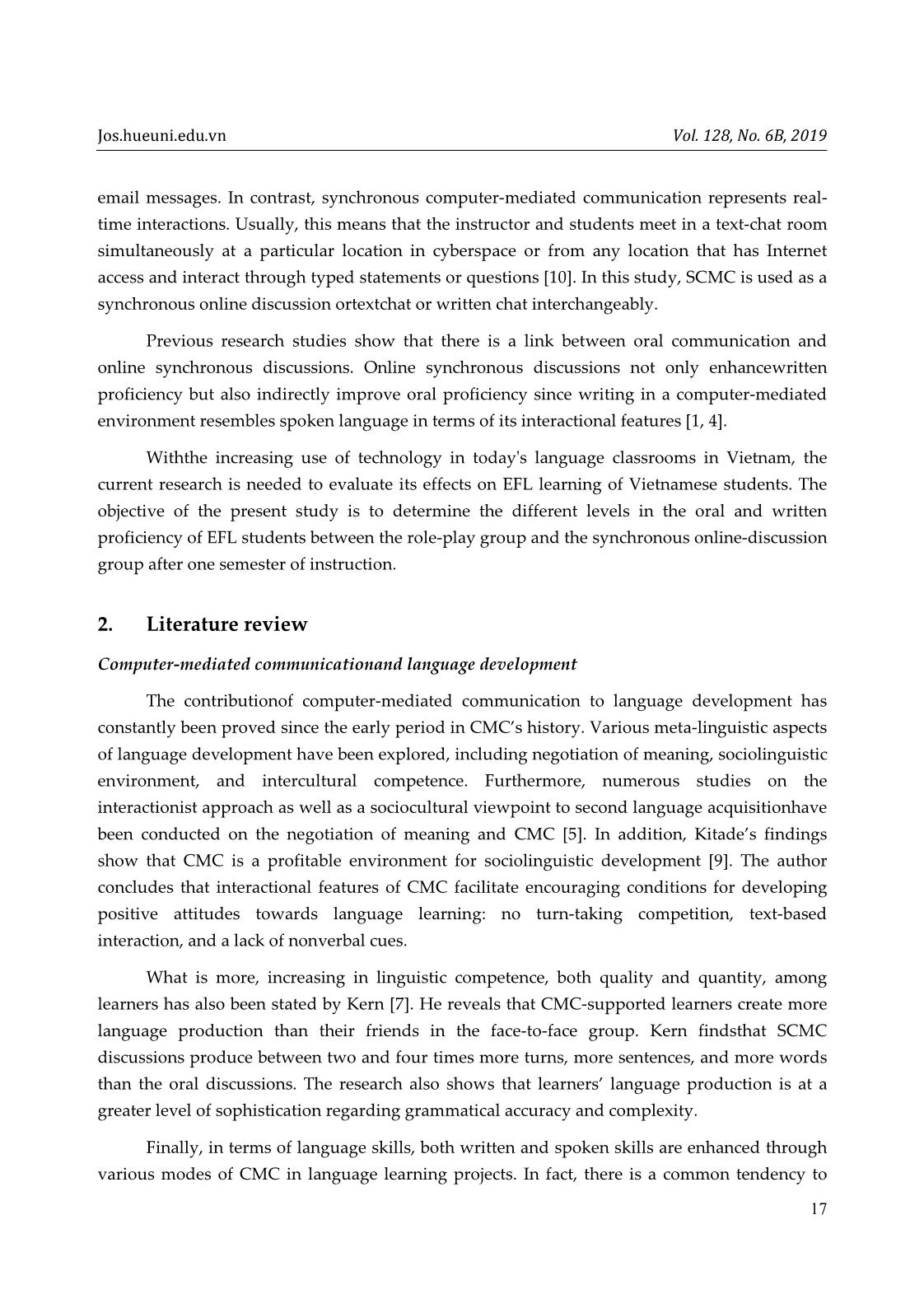
Trang 2
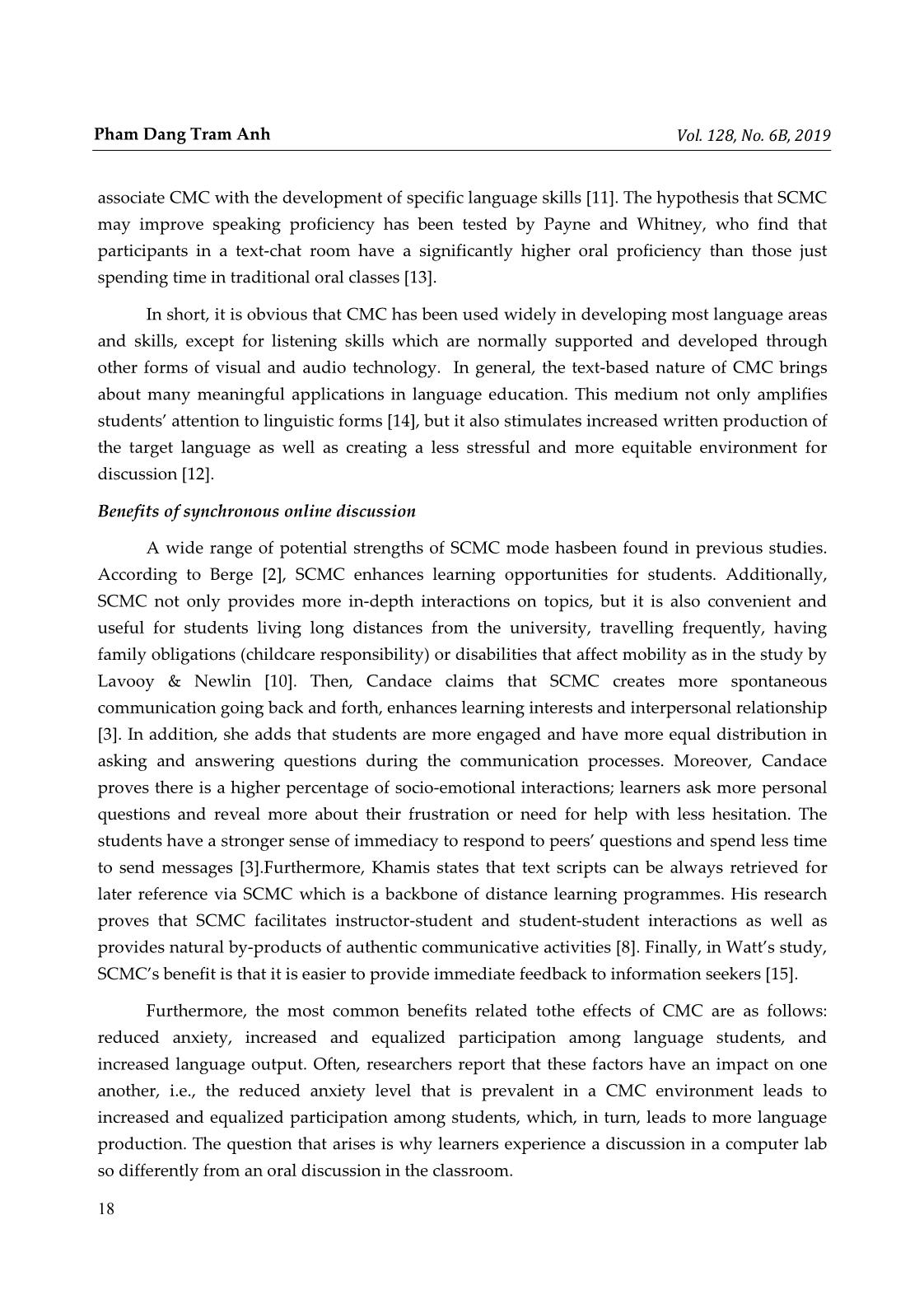
Trang 3
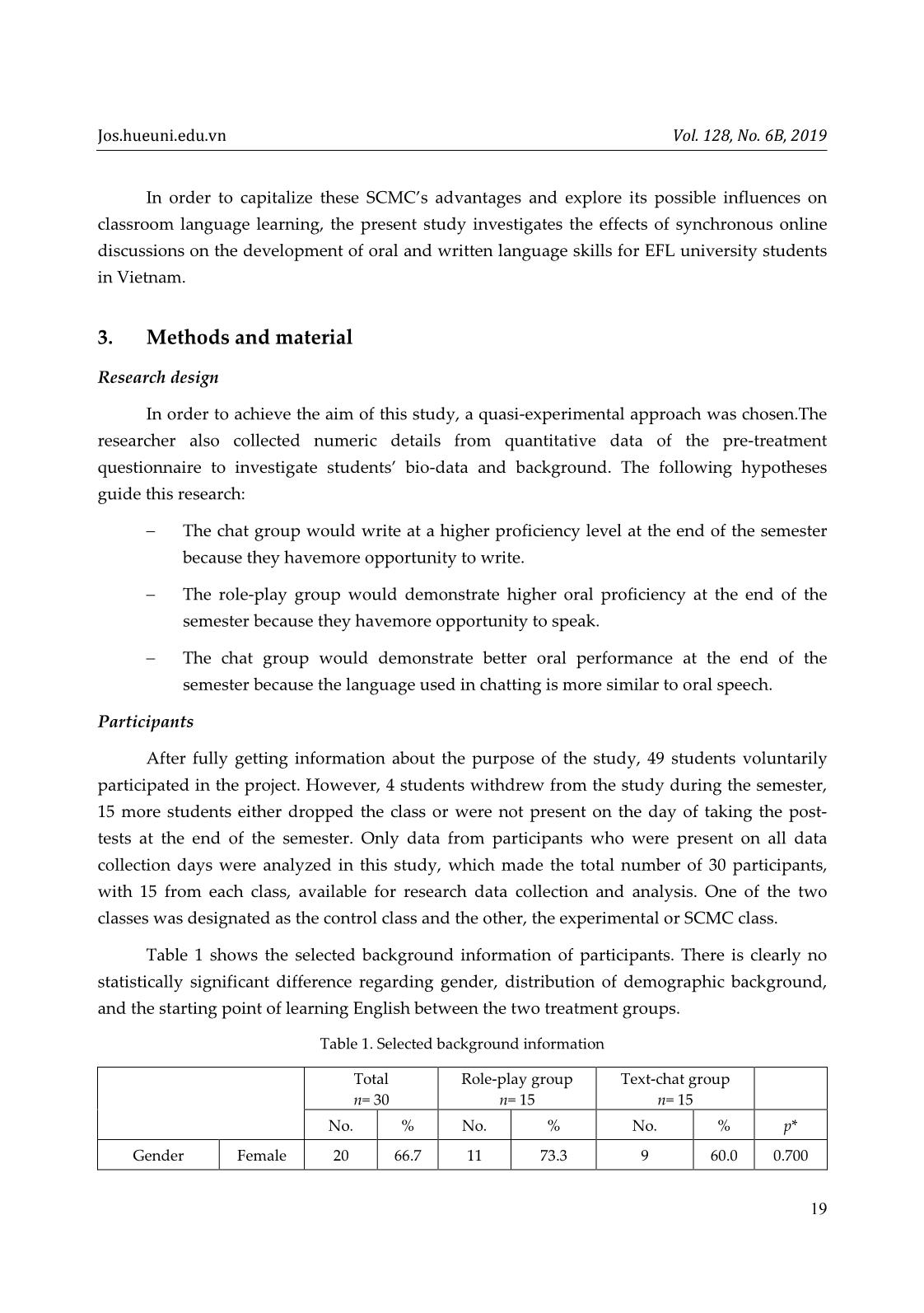
Trang 4
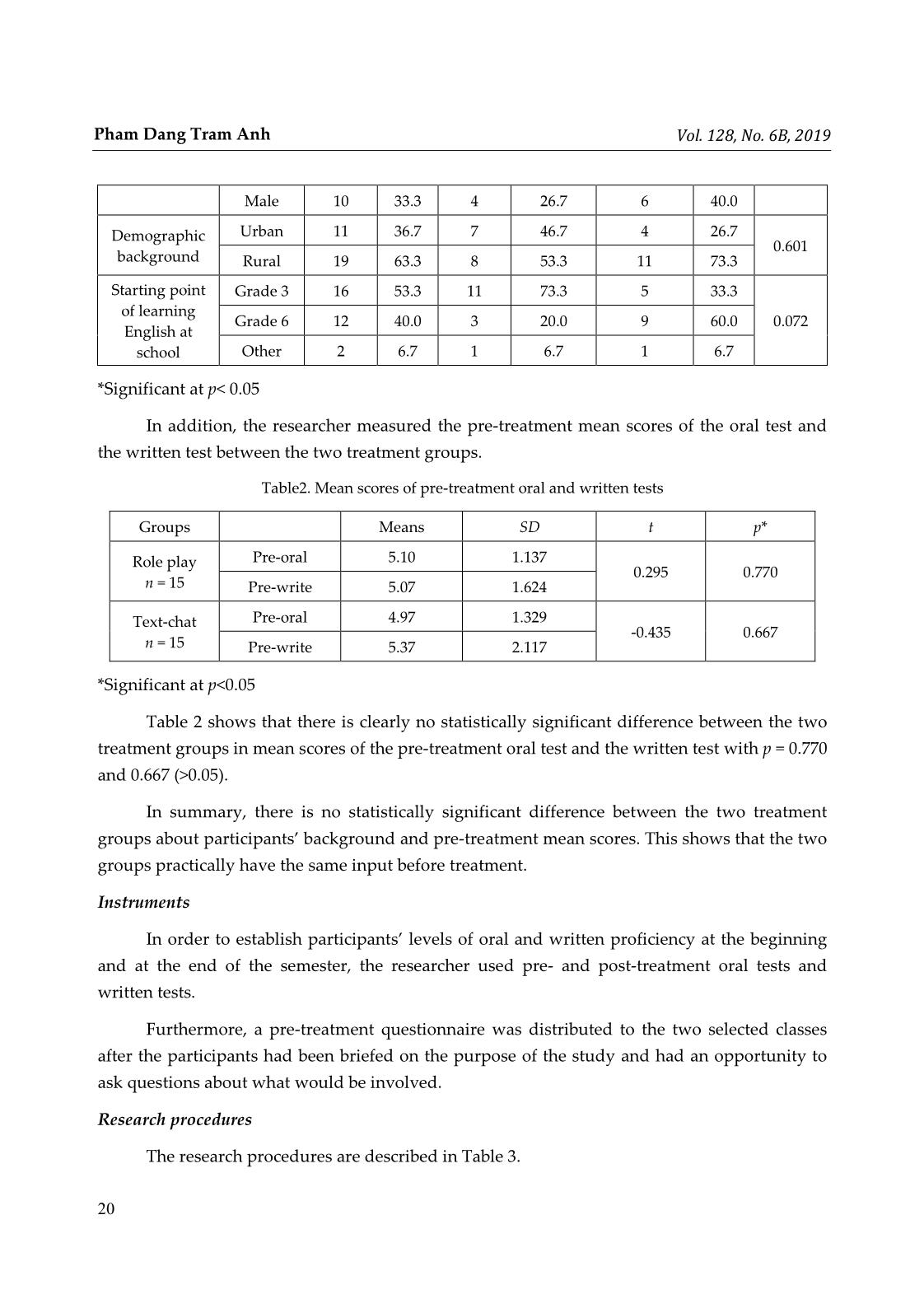
Trang 5
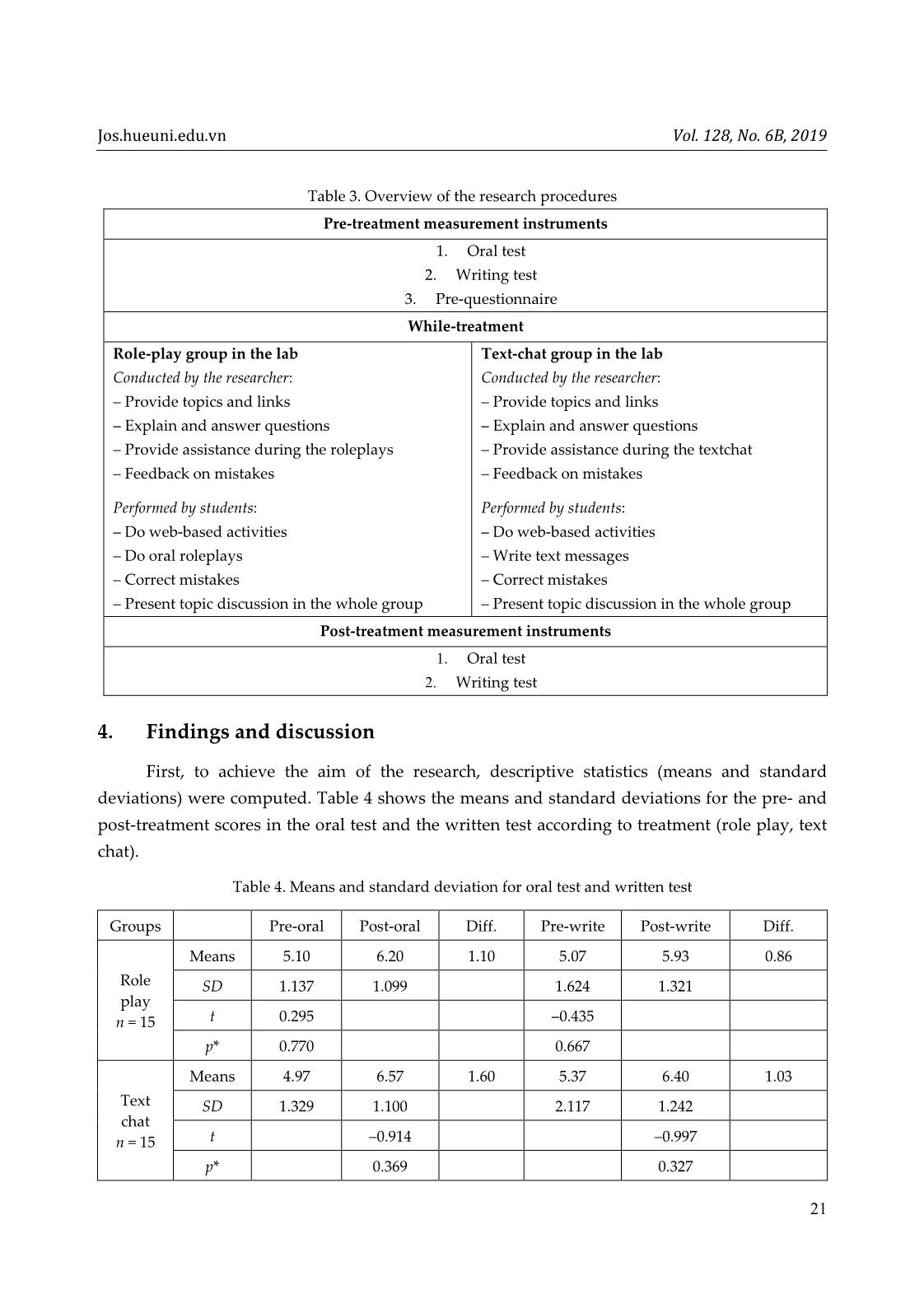
Trang 6
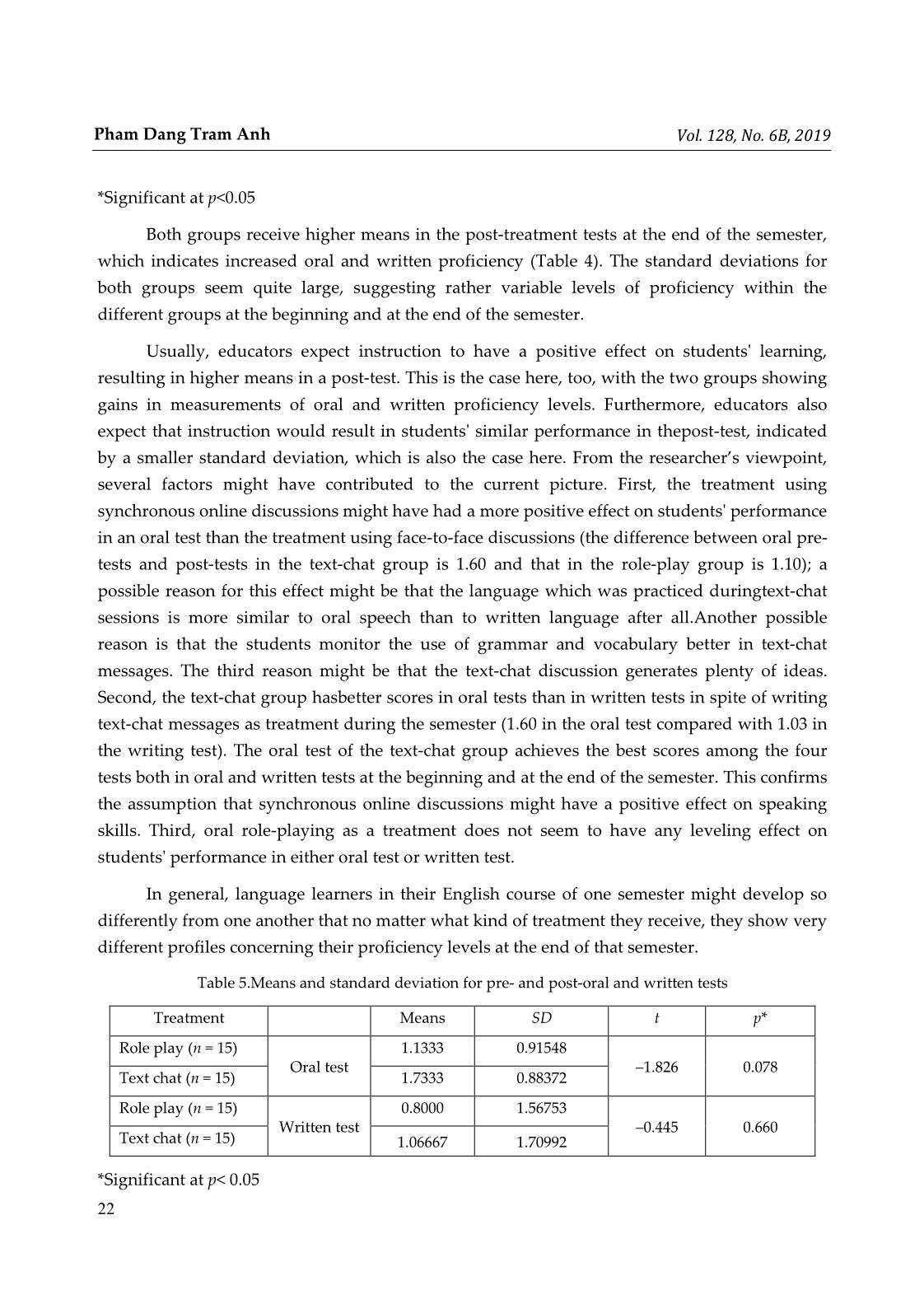
Trang 7
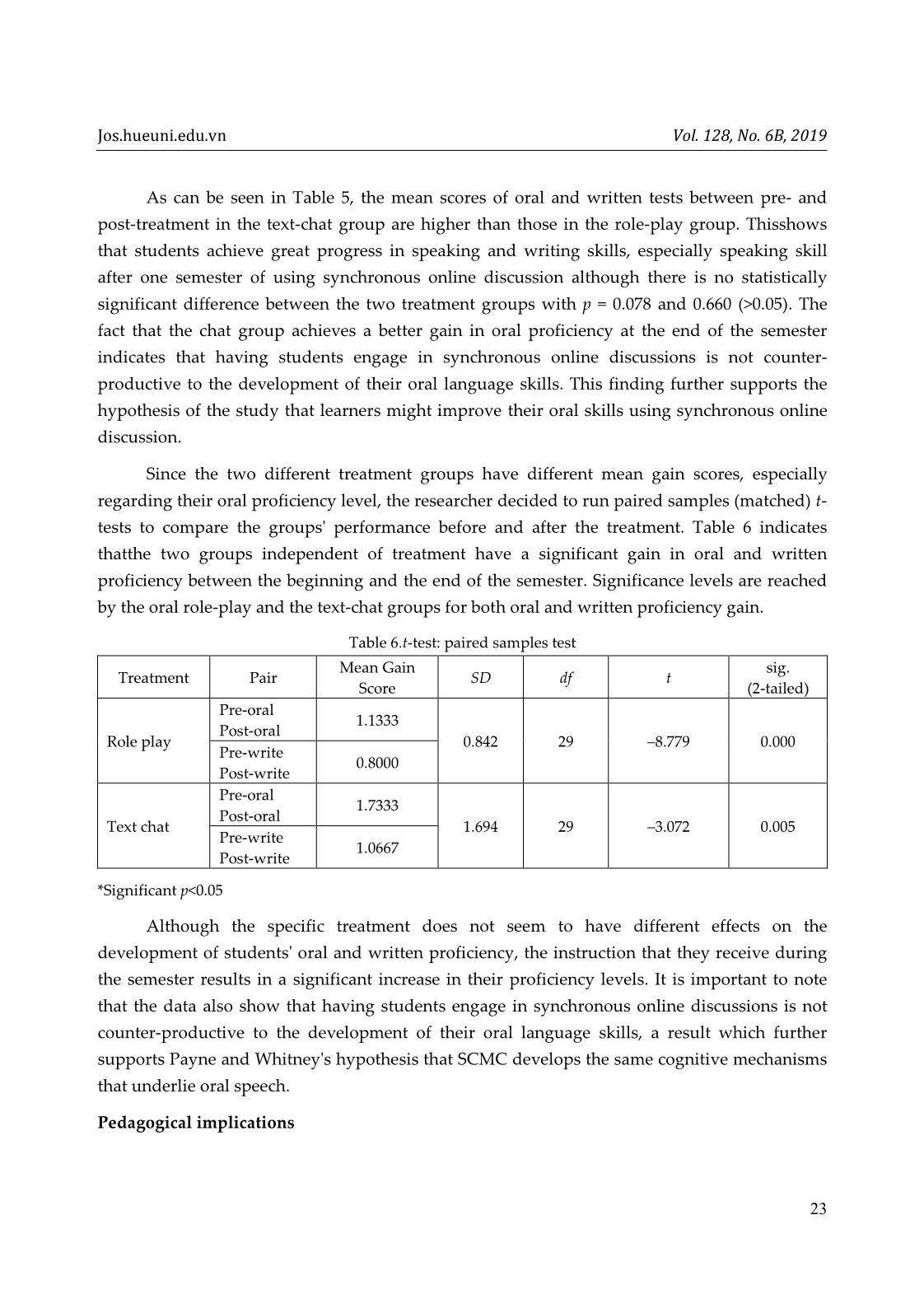
Trang 8
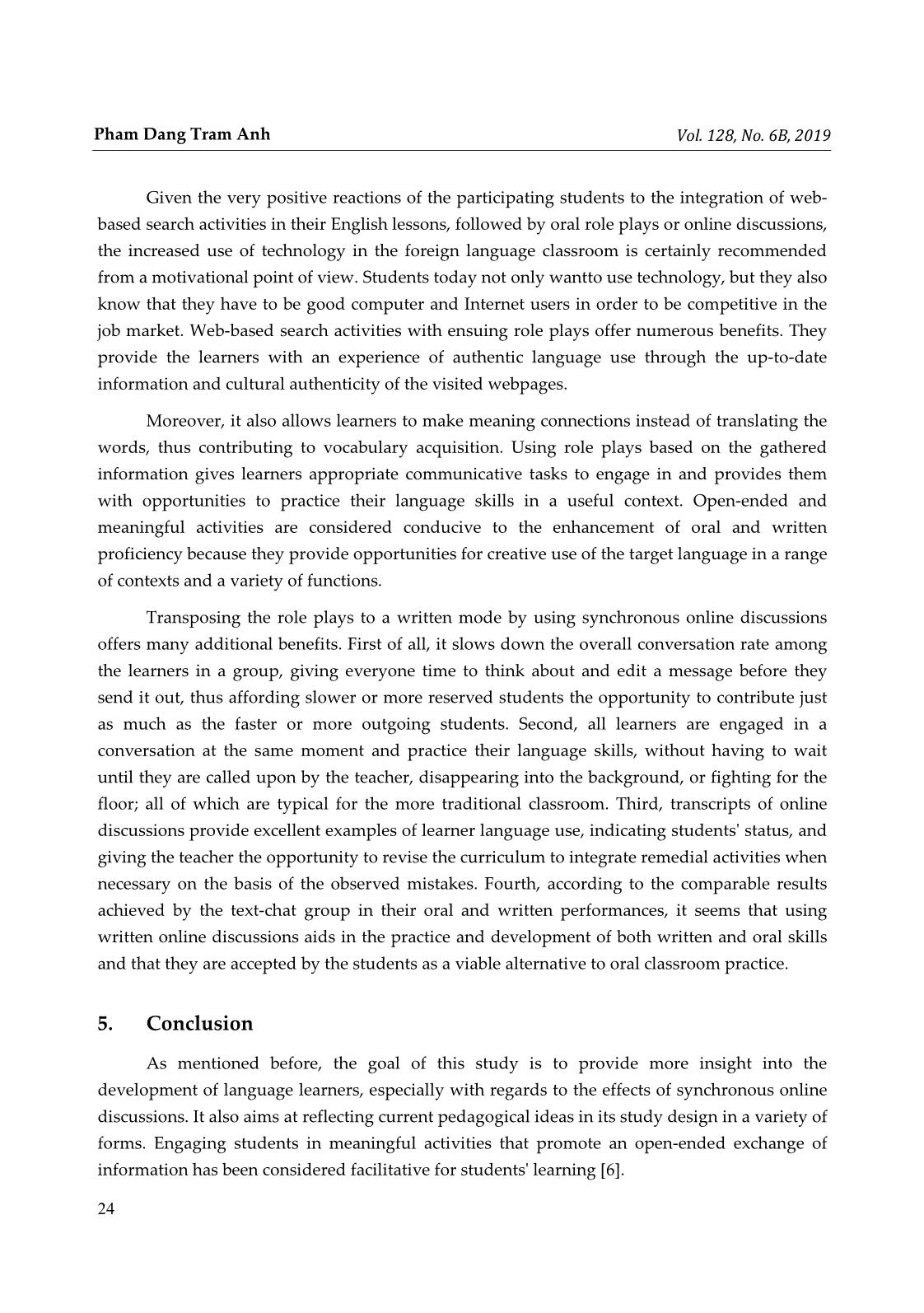
Trang 9
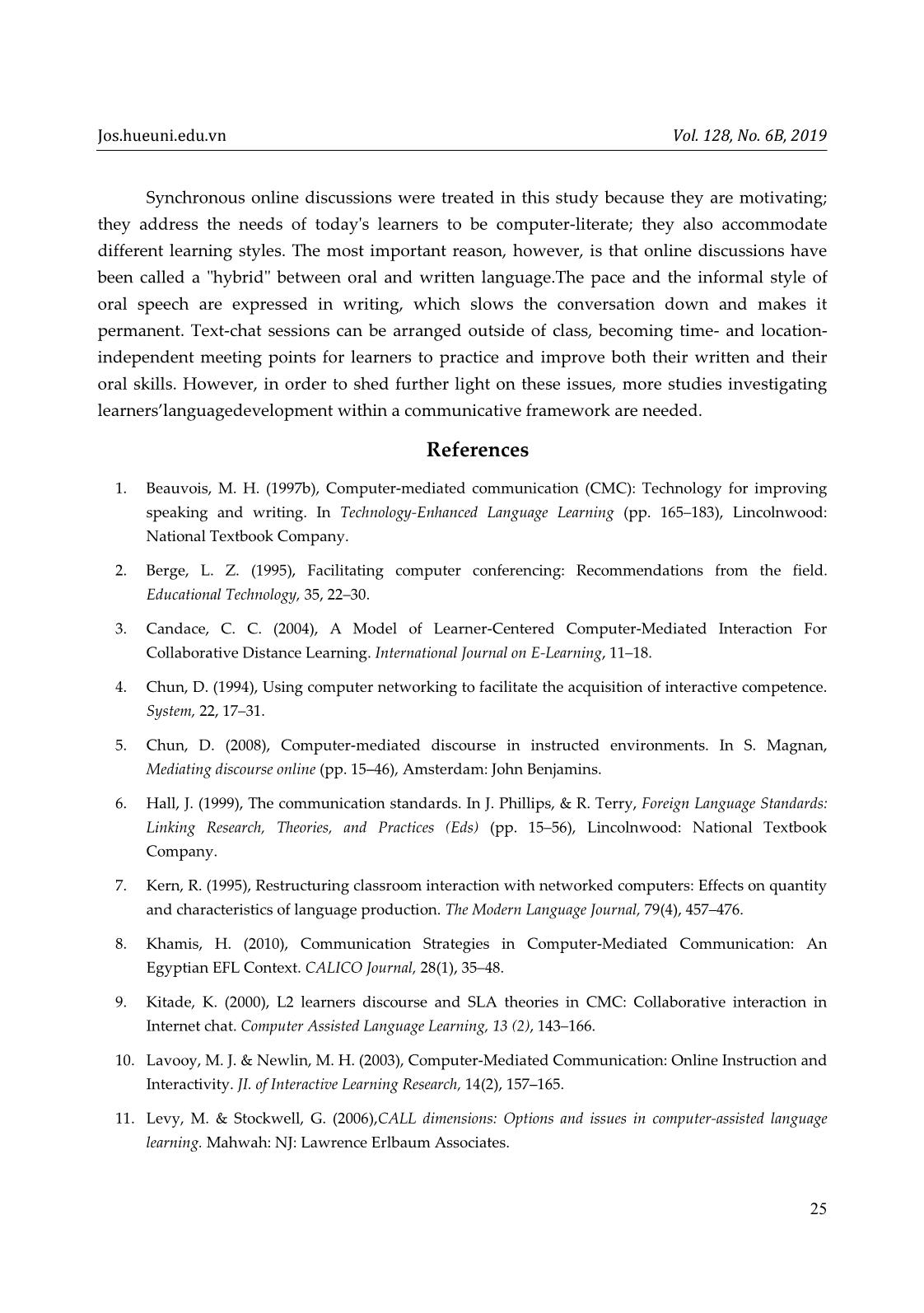
Trang 10
Tải về để xem bản đầy đủ
Tóm tắt nội dung tài liệu: Quantitative analysis of the effect of synchronous online discussions on oral and written language development for efl university students in Vietnam
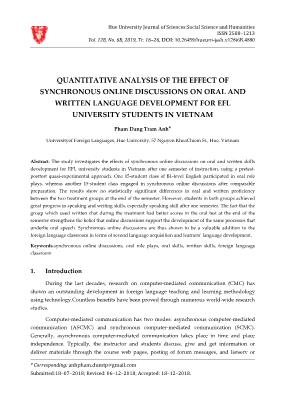
Hue University Journal of Sciences:Social Science and Humanities ISSN 2588–1213 Vol. 128, No. 6B, 2019, Tr. 16–26, DOI: 10.26459/hueuni-jssh.v128i6B.4880 * Corresponding: anhpham.dumtp@gmail.com Submitted:18–07–2018; Revised: 06–12–2018; Accepted: 18–12–2018. QUANTITATIVE ANALYSIS OF THE EFFECT OF SYNCHRONOUS ONLINE DISCUSSIONS ON ORAL AND WRITTEN LANGUAGE DEVELOPMENT FOR EFL UNIVERSITY STUDENTS IN VIETNAM Pham Dang Tram Anh* Universityof Foreign Languages, Hue University, 57 Nguyen KhoaChiem St., Hue, Vietnam Abstract. The study investigates the effects of synchronous online discussions on oral and written skills development for EFL university students in Vietnam after one semester of instruction, using a pretest- posttest quasi-experimental approach. One 15-student class of B1-level English participated in oral role plays, whereas another 15-student class engaged in synchronous online discussions after comparable preparation. The results show no statistically significant differences in oral and written proficiency between the two treatment groups at the end of the semester. However, students in both groups achieved great progress in speaking and writing skills, especially speaking skill after one semester. The fact that the group which used written chat during the treatment had better scores in the oral test at the end of the semester strengthens the belief that online discussions support the development of the same processes that underlie oral speech. Synchronous online discussions are thus shown to be a valuable addition to the foreign language classroom in terms of second language acquisition and learners’ language development. Keywords.synchronous online discussions, oral role plays, oral skills, written skills, foreign language classroom 1. Introduction During the last decades, research on computer-mediated communication (CMC) has shown an outstanding development in foreign language teaching and learning methodology using technology.Countless benefits have been proved through numerous world-wide research studies. Computer-mediated communication has two modes: asynchronous computer-mediated communication (ASCMC) and synchronous computer-mediated communication (SCMC). Generally, asynchronous computer-mediated communication takes place in time and place independence. Typically, the instructor and students discuss, give and get information or deliver materials through the course web pages, posting of forum messages, and listserv or Jos.hueuni.edu.vn Vol. 128, No. 6B, 2019 17 email messages. In contrast, synchronous computer-mediated communication represents real- time interactions. Usually, this means that the instructor and students meet in a text-chat room simultaneously at a particular location in cyberspace or from any location that has Internet access and interact through typed statements or questions [10]. In this study, SCMC is used as a synchronous online discussion ortextchat or written chat interchangeably. Previous research studies show that there is a link between oral communication and online synchronous discussions. Online synchronous discussions not only enhancewritten proficiency but also indirectly improve oral proficiency since writing in a computer-mediated environment resembles spoken language in terms of its interactional features [1, 4]. Withthe increasing use of technology in today's language classrooms in Vietnam, the current research is needed to evaluate its effects on EFL learning of Vietnamese students. The objective of the present study is to determine the different levels in the oral and written proficiency of EFL students between the role-play group and the synchronous online-discussion group after one semester of instruction. 2. Literature review Computer-mediated communicationand language development The contributionof computer-mediated communication to language development has constantly been proved since the early period in CMC’s history. Various meta-linguistic aspects of language development have been explored, including negotiation of meaning, sociolinguistic environment, and intercultural competence. Furthermore, numerous studies on the interactionist approach as well as a sociocultural viewpoint to second language acquisitionhave been conducted on the negotiation of meaning and CMC [5]. In addition, Kitade’s findings show that CMC is a profitable environment for sociolinguistic development [9]. The author concludes that interactional features of CMC facilitate encouraging conditions for developing positive attitudes towards language learning: no turn-taking competition, text-based interaction, and a lack of nonverbal cues. What is more, increasing in linguistic competence, both quality and quantity, among learners has also been stated by Kern [7]. He reveals that CMC-supported learners create more language production than their friends in the face-to-face group. Kern findsthat SCMC discussions produce between two and four times more turns, more sentences, and more words than the oral discussions. The research also shows that learners’ language production is at a greater level of sophistication regarding grammatical accuracy and complexity. Finally, in terms of language skills, both written and spoken skills are enhanced through various modes of CMC in language learning projects. In fact, there is a common tendency to Pham Dang Tram Anh Vol. 128, No. 6B, 2019 18 associate CMC with the development of specific language skills [11]. The hypothesis that SCMC may improve speaking proficiency has been tested by Payne and Whitney, who find that participants in a text-chat room have a significantly higher oral proficiency than those just spending time in traditional oral classes [13]. In short, it is obvious that CMC has been used widely in developing most language areas and skills, except for listening skills ... en tests. Furthermore, a pre-treatment questionnaire was distributed to the two selected classes after the participants had been briefed on the purpose of the study and had an opportunity to ask questions about what would be involved. Research procedures The research procedures are described in Table 3. Jos.hueuni.edu.vn Vol. 128, No. 6B, 2019 21 Table 3. Overview of the research procedures Pre-treatment measurement instruments 1. Oral test 2. Writing test 3. Pre-questionnaire While-treatment Role-play group in the lab Conducted by the researcher: – Provide topics and links – Explain and answer questions – Provide assistance during the roleplays – Feedback on mistakes Performed by students: – Do web-based activities – Do oral roleplays – Correct mistakes – Present topic discussion in the whole group Text-chat group in the lab Conducted by the researcher: – Provide topics and links – Explain and answer questions – Provide assistance during the textchat – Feedback on mistakes Performed by students: – Do web-based activities – Write text messages – Correct mistakes – Present topic discussion in the whole group Post-treatment measurement instruments 1. Oral test 2. Writing test 4. Findings and discussion First, to achieve the aim of the research, descriptive statistics (means and standard deviations) were computed. Table 4 shows the means and standard deviations for the pre- and post-treatment scores in the oral test and the written test according to treatment (role play, text chat). Table 4. Means and standard deviation for oral test and written test Groups Pre-oral Post-oral Diff. Pre-write Post-write Diff. Role play n = 15 Means 5.10 6.20 1.10 5.07 5.93 0.86 SD 1.137 1.099 1.624 1.321 t 0.295 –0.435 p* 0.770 0.667 Text chat n = 15 Means 4.97 6.57 1.60 5.37 6.40 1.03 SD 1.329 1.100 2.117 1.242 t –0.914 –0.997 p* 0.369 0.327 Pham Dang Tram Anh Vol. 128, No. 6B, 2019 22 *Significant at p<0.05 Both groups receive higher means in the post-treatment tests at the end of the semester, which indicates increased oral and written proficiency (Table 4). The standard deviations for both groups seem quite large, suggesting rather variable levels of proficiency within the different groups at the beginning and at the end of the semester. Usually, educators expect instruction to have a positive effect on students' learning, resulting in higher means in a post-test. This is the case here, too, with the two groups showing gains in measurements of oral and written proficiency levels. Furthermore, educators also expect that instruction would result in students' similar performance in thepost-test, indicated by a smaller standard deviation, which is also the case here. From the researcher’s viewpoint, several factors might have contributed to the current picture. First, the treatment using synchronous online discussions might have had a more positive effect on students' performance in an oral test than the treatment using face-to-face discussions (the difference between oral pre- tests and post-tests in the text-chat group is 1.60 and that in the role-play group is 1.10); a possible reason for this effect might be that the language which was practiced duringtext-chat sessions is more similar to oral speech than to written language after all.Another possible reason is that the students monitor the use of grammar and vocabulary better in text-chat messages. The third reason might be that the text-chat discussion generates plenty of ideas. Second, the text-chat group hasbetter scores in oral tests than in written tests in spite of writing text-chat messages as treatment during the semester (1.60 in the oral test compared with 1.03 in the writing test). The oral test of the text-chat group achieves the best scores among the four tests both in oral and written tests at the beginning and at the end of the semester. This confirms the assumption that synchronous online discussions might have a positive effect on speaking skills. Third, oral role-playing as a treatment does not seem to have any leveling effect on students' performance in either oral test or written test. In general, language learners in their English course of one semester might develop so differently from one another that no matter what kind of treatment they receive, they show very different profiles concerning their proficiency levels at the end of that semester. Table 5.Means and standard deviation for pre- and post-oral and written tests Treatment Means SD t p* Role play (n = 15) Oral test 1.1333 0.91548 –1.826 0.078 Text chat (n = 15) 1.7333 0.88372 Role play (n = 15) Written test 0.8000 1.56753 –0.445 0.660 Text chat (n = 15) 1.06667 1.70992 *Significant at p< 0.05 Jos.hueuni.edu.vn Vol. 128, No. 6B, 2019 23 As can be seen in Table 5, the mean scores of oral and written tests between pre- and post-treatment in the text-chat group are higher than those in the role-play group. Thisshows that students achieve great progress in speaking and writing skills, especially speaking skill after one semester of using synchronous online discussion although there is no statistically significant difference between the two treatment groups with p = 0.078 and 0.660 (>0.05). The fact that the chat group achieves a better gain in oral proficiency at the end of the semester indicates that having students engage in synchronous online discussions is not counter- productive to the development of their oral language skills. This finding further supports the hypothesis of the study that learners might improve their oral skills using synchronous online discussion. Since the two different treatment groups have different mean gain scores, especially regarding their oral proficiency level, the researcher decided to run paired samples (matched) t- tests to compare the groups' performance before and after the treatment. Table 6 indicates thatthe two groups independent of treatment have a significant gain in oral and written proficiency between the beginning and the end of the semester. Significance levels are reached by the oral role-play and the text-chat groups for both oral and written proficiency gain. Table 6.t-test: paired samples test Treatment Pair Mean Gain Score SD df t sig. (2-tailed) Role play Pre-oral Post-oral 1.1333 0.842 29 –8.779 0.000 Pre-write Post-write 0.8000 Text chat Pre-oral Post-oral 1.7333 1.694 29 –3.072 0.005 Pre-write Post-write 1.0667 *Significant p<0.05 Although the specific treatment does not seem to have different effects on the development of students' oral and written proficiency, the instruction that they receive during the semester results in a significant increase in their proficiency levels. It is important to note that the data also show that having students engage in synchronous online discussions is not counter-productive to the development of their oral language skills, a result which further supports Payne and Whitney's hypothesis that SCMC develops the same cognitive mechanisms that underlie oral speech. Pedagogical implications Pham Dang Tram Anh Vol. 128, No. 6B, 2019 24 Given the very positive reactions of the participating students to the integration of web- based search activities in their English lessons, followed by oral role plays or online discussions, the increased use of technology in the foreign language classroom is certainly recommended from a motivational point of view. Students today not only wantto use technology, but they also know that they have to be good computer and Internet users in order to be competitive in the job market. Web-based search activities with ensuing role plays offer numerous benefits. They provide the learners with an experience of authentic language use through the up-to-date information and cultural authenticity of the visited webpages. Moreover, it also allows learners to make meaning connections instead of translating the words, thus contributing to vocabulary acquisition. Using role plays based on the gathered information gives learners appropriate communicative tasks to engage in and provides them with opportunities to practice their language skills in a useful context. Open-ended and meaningful activities are considered conducive to the enhancement of oral and written proficiency because they provide opportunities for creative use of the target language in a range of contexts and a variety of functions. Transposing the role plays to a written mode by using synchronous online discussions offers many additional benefits. First of all, it slows down the overall conversation rate among the learners in a group, giving everyone time to think about and edit a message before they send it out, thus affording slower or more reserved students the opportunity to contribute just as much as the faster or more outgoing students. Second, all learners are engaged in a conversation at the same moment and practice their language skills, without having to wait until they are called upon by the teacher, disappearing into the background, or fighting for the floor; all of which are typical for the more traditional classroom. Third, transcripts of online discussions provide excellent examples of learner language use, indicating students' status, and giving the teacher the opportunity to revise the curriculum to integrate remedial activities when necessary on the basis of the observed mistakes. Fourth, according to the comparable results achieved by the text-chat group in their oral and written performances, it seems that using written online discussions aids in the practice and development of both written and oral skills and that they are accepted by the students as a viable alternative to oral classroom practice. 5. Conclusion As mentioned before, the goal of this study is to provide more insight into the development of language learners, especially with regards to the effects of synchronous online discussions. It also aims at reflecting current pedagogical ideas in its study design in a variety of forms. Engaging students in meaningful activities that promote an open-ended exchange of information has been considered facilitative for students' learning [6]. Jos.hueuni.edu.vn Vol. 128, No. 6B, 2019 25 Synchronous online discussions were treated in this study because they are motivating; they address the needs of today's learners to be computer-literate; they also accommodate different learning styles. The most important reason, however, is that online discussions have been called a "hybrid" between oral and written language.The pace and the informal style of oral speech are expressed in writing, which slows the conversation down and makes it permanent. Text-chat sessions can be arranged outside of class, becoming time- and location- independent meeting points for learners to practice and improve both their written and their oral skills. However, in order to shed further light on these issues, more studies investigating learners’languagedevelopment within a communicative framework are needed. References 1. Beauvois, M. H. (1997b), Computer-mediated communication (CMC): Technology for improving speaking and writing. In Technology-Enhanced Language Learning (pp. 165–183), Lincolnwood: National Textbook Company. 2. Berge, L. Z. (1995), Facilitating computer conferencing: Recommendations from the field. Educational Technology, 35, 22–30. 3. Candace, C. C. (2004), A Model of Learner-Centered Computer-Mediated Interaction For Collaborative Distance Learning. International Journal on E-Learning, 11–18. 4. Chun, D. (1994), Using computer networking to facilitate the acquisition of interactive competence. System, 22, 17–31. 5. Chun, D. (2008), Computer-mediated discourse in instructed environments. In S. Magnan, Mediating discourse online (pp. 15–46), Amsterdam: John Benjamins. 6. Hall, J. (1999), The communication standards. In J. Phillips, & R. Terry, Foreign Language Standards: Linking Research, Theories, and Practices (Eds) (pp. 15–56), Lincolnwood: National Textbook Company. 7. Kern, R. (1995), Restructuring classroom interaction with networked computers: Effects on quantity and characteristics of language production. The Modern Language Journal, 79(4), 457–476. 8. Khamis, H. (2010), Communication Strategies in Computer-Mediated Communication: An Egyptian EFL Context. CALICO Journal, 28(1), 35–48. 9. Kitade, K. (2000), L2 learners discourse and SLA theories in CMC: Collaborative interaction in Internet chat. Computer Assisted Language Learning, 13 (2), 143–166. 10. Lavooy, M. J. & Newlin, M. H. (2003), Computer-Mediated Communication: Online Instruction and Interactivity. JI. of Interactive Learning Research, 14(2), 157–165. 11. Levy, M. & Stockwell, G. (2006),CALL dimensions: Options and issues in computer-assisted language learning. Mahwah: NJ: Lawrence Erlbaum Associates. Pham Dang Tram Anh Vol. 128, No. 6B, 2019 26 12. Nguyen Van Long (2011),Computer-mediated collaborative learning in a Vietnamese tertiary EFL context: Process, Product, and Learners' Perceptions. Palmerston North, New Zealand: Doctoral Dissertation, Massey University. 13. Payne, J. & Whitney, P. (2002), Developing L2 oral proficiency through synchronous CMC: Output, working memory, and interlanguage development. CALICO, 20(1), 7–32. 14. Wang, Y. (2004), Supporting synchronous distance language learning with desktop videoconferencing. Language Learning & Technology, 8(3), 90–122. 15. Watts, L. (2016), Synchronous and asynchronous communication in distance learning. The Quarterly Review of Distance Education, 17(1), 23–32.
File đính kèm:
 quantitative_analysis_of_the_effect_of_synchronous_online_di.pdf
quantitative_analysis_of_the_effect_of_synchronous_online_di.pdf

